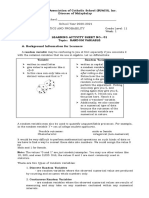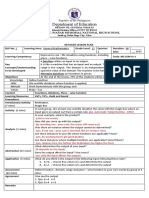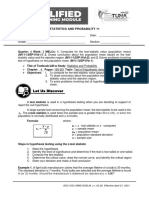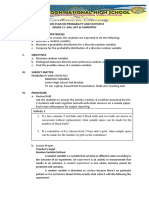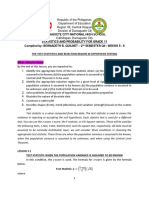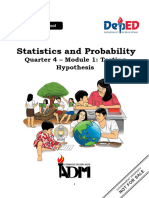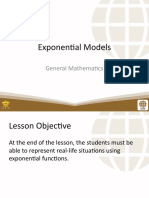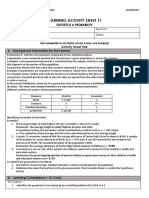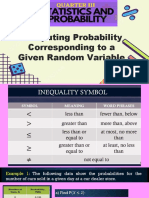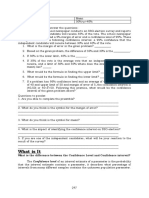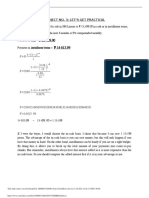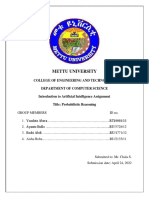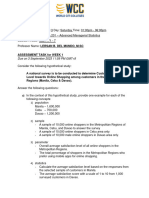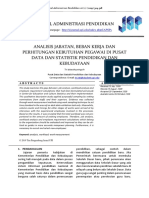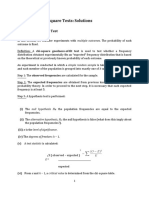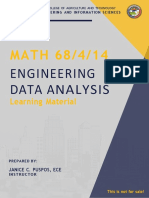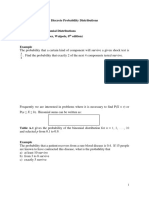Grade 11
STATISTICS AND PROBABILITY
Module 1-2 : Exploring Random Variable and
Constructing Probability Distribution
2nd Semester, S.Y. 2020-2021
Prepared by:
MARIO A. ANACLETO JR.
Subject Teacher
________________________________________________________________________________
MDM-Sagay College, Inc.
Office: Feliza Bldg., Marañon St. Pob 2, Sagay City
Campus: National Highway, Poblacion 2, Sagay City, Negros Occidental
Tel.# 488-0531/ email: mdm_sagay2000@gmail.com.
1
�What I Know
Choose the letter of the best answer. Write the chosen letter on a separate sheet of paper.
1. It is the branch of mathematics concerned with the techniques by which data are collected,
organized, analyzed, and interpreted.
a. Information Technology c. Trigonometry
b. Statistics d. Geometry
2. It is a method of selecting the elements of a sample from population under consideration.
a. Sampling c. Organizing
b. Drawing d. Sampling
3. Mrs. Borromeo wants to study the heights and weights of the students in her class. Which of the
following samples is most likely to be a good representation of the whole class?
a. A sample consisting of all students whose surnames start with E.
b. A sample consisting of all athletes in the class.
c. A sample consisting of students whose birthday are from January to June.
d. A Sample consisting of the students whose names were out of a box which contained all
the names of the students in the class.
4. Which of the following means ∑5𝑖=1 𝑥𝑖
a. 1+2+3+4+5
b. X+2x+3x+4x+5x
c. 𝑥1 + 𝑥2 + 𝑥3 + 𝑥4 + 𝑥5
d. 𝑛𝑜𝑛𝑒 𝑜𝑓 𝑡ℎ𝑒 𝑎𝑏𝑜𝑣𝑒
5. It is the set of all possible outcomes of an experiment is called?
a. Mean c. Sample space
b. Median d. Random variable
6. Is a function that associates a real number to each element in the sample space.
a. Mean c. Sample Space
b. Median d. Random variable
7. A random variable that represent count data, such as the number of defective chairs produce in
a factory.
a. Discrete random variable c. Random variable
b. Continuous random variable d. Sample space.
8. A random variable that represent measured data, such as heights, weights, and temperature?
a. Discrete random variable c. Random variable.
b. Continuous random variable d. Sample space.
9. How many possible outcomes when we used three coins are tossed?
a. 4 c. 7
b. 6 d. 8
10. Which of the following are classify as Discrete Random Variable?
a. The weight of a newborn each year in a hospital.
b. The number of female athletes.
c. The speed of a car.
d. The amount of sugar in a cup of coffee.
2
�Module 1: Exploring Random Variable
Lesson Objective
At the end of this lesson, you are expected to:
Illustrate a random variable;
Classify random variable as discrete or continuous; and
Find the possible values of a random variable.
What’s New
In our previous study of mathematics, we encountered the concept of probability. How do we use this
concept in making decisions concerning a population using a sample?
Decision-making is an important aspect in business, education, insurance and other real-life situations.
Many decisions are made by assigning probabilities to all possible outcomes pertaining to the situation
and then evaluating the results.
For instance, an insurance company might be able to assign probabilities to the number of vehicles a
family owns. This information will help the company in making decisions regarding future finance
situations. This situation requires the use of a random variables and the probability distribution.
Random Variables
Is a function that’s associates a real number to each element in the sample space. It is a variable whose
values are determined by chance.
Suppose that to each point of a sample space we assign a number. We then have a function defined on
the sample space. This function is called a random variable (or stochastic variable) or more precisely a
random function (stochastic function). It is usually denoted by a capital letter such as X or Y. In general, a
random variable
has some specified physical, geometrical, or other significance.
EXAMPLE 1: Tossing two Coins
Suppose that a two coin is tossed twice so that the sample space is S = {HH, HT, TH, TT}. Let X represent
the number of heads that can come up. With each sample point we can associate a number for X as
shown in Table1.
Possible outcome Value of the Random Variable X
(Sample Point) (number of Heads)
HH
HT
TH
TT
3
� 1. Base on the table 1. U need to determine the sample space. Let H represent head and the T
represent Tail. For two coin tossed, we came up only for this possible combination S =
{HH,HT,TH,TT} no matter how many times you tossed the coins this are only possible
combination u will get.
2. Then, after you get the possible outcomes, Count the number of Heads in each outcome in the
sample space and assign this number, Shown in Table below;
Possible outcome Value of the Random Variable X
(Sample Point) (number of Heads)
HH 2
HT 1
TH 1
TT 0
3. So, the possible values of the random variable X are 0,1,2, and 3
Mathematical Journal
The random variables in the Example activities is called discrete random variable. Because the set of
possible outcomes is countable.
A Random Variable is a discrete random variable if its set of possible outcomes is countable, Mostly,
discrete random variable represents count data, such as the number of the defective chairs produced in
a factory.
A random variable I a continuous random variable if it takes on values on continuous scale, often,
continuous random variable represents measured data, such as heights, weights, and temperatures.
What I Can Do
Instructions: Get separate sheet of paper and answer the following:
1. Classify the following random variables as discrete or continuous. Write it in your paper correspond to the
letter.
a. The number of defective computers produce by manufacturer
b. The weight of a newborn each year in a hospital
c. The number of siblings in a family of a region
d. The amount of paint utilized in a building project
e. The number of dropouts in a school district for period of 10 years
f. The speed of a car
g. The number of female athletes
h. The time needed to finish the test
i. The amount of sugar in a cup of coffee
j. The number of people who are playing LOTTO each day
k. The number of voters favoring a candidate
l. The number of accidents per year at an intersection
m. The number of bushels of apples per hectare this year
n. The number of patient arrivals per hour at a medical clinic
o. The average amount of electricity consumed per household per month
p. The number of deaths per year attributed to lung cancer
4
� 2. Find out if you have learned in this lesson, do the following activity:
Tossing Three Coins
Suppose three coins are tossed. Let Y be the random variable representing the number of tails that occur. Find the
values of the random variable Y. Complete the table below.
Value of the Variable Y
Possible Outcomes
(number of tails)
3. In your own words, answer the following questions,
a. How do you find the values of a random variable?
b. How do you know whether a random variable is continuous or discrete?
c. What is the difference between continuous and discrete random variables?
Module 2: Constructing Probability Distribution
Lesson Objective
At the end of this lesson, you are expected to:
Illustrate a probability distribution for a discrete random variable and its properties;
Compute probabilities corresponding to a given random variable; and
Construct the probability mass function of a discrete random variable and its corresponding
histogram.
What’s New
A probability distribution is a function that describes the likelihood of obtaining the possible values that
a random variable can assume. In other words, the values of the variable vary based on the underlying
probability distribution.
Suppose you draw a random sample and measure the heights of the subjects. As you measure heights,
you can create a distribution of heights. This type of distribution is useful when you need to know which
outcomes are most likely, the spread of potential values, and the likelihood of different results.
In this blog post, you’ll learn about probability distributions for both discrete and continuous variables.
I’ll show you how they work and examples of how to use them.
General Properties of Probability Distributions
Probability distributions indicate the likelihood of an event or outcome. Statisticians use the following
notation to describe probabilities:
5
�p(x) = the likelihood that random variable takes a specific value of x.
The sum of all probabilities for all possible values must equal 1. Furthermore, the probability for a
particular value or range of values must be between 0 and 1.
Probability distributions describe the dispersion of the values of a random variable. Consequently, the
kind of variable determines the type of probability distribution. For a single random variable,
statisticians divide distributions into the following two types:
Discrete probability distributions for discrete variables
Probability density functions for continuous variables
You can use equations and tables of variable values and probabilities to represent a probability
distribution. However, I prefer graphing them using probability distribution plots. As you’ll see in the
examples that follow, the differences between discrete and continuous probability distributions are
immediately apparent.
EXAMPLE 1: NUMBER OF TAILS
Suppose three coin are tossed. Let Y be the random variable representing the number of tails that occur.
Find the probability of each of the values of the random variable Y.
SOLUTION:
1. Determine the sample space. Let H represent head and T represent Tail
The sample space for this experiment is:
S = { TTT, TTH, THT, HTT, HHT, HTH, THH, HHH}
2. Count the number of tails in each outcome in the sample space and assign this number to this outcome.
Value of the Random
Possible Outcomes Variable
(Number of tails)
TTT 3
TTH 2
THT 2
HTT 2
HHT 1
HTH 1
THH 1
HHH 0
3. There are four possible values of the random variable Y representing the number of tails. These are 0, 1,
2, and 3. Assign Probability values P(Y) to each value of the random variable.
Number of Tails Y Probability P(Y)
There are 8 possible outcome and no tail occurs
0 1/8 once, so the probability that we shall assign to
the random variable 0 is 1/8
6
� There are 8 possible outcome and 1 tail occurs
1 3/8 three times, so the probability that we shall
assign to the random variable 1 is 3/8
There are 8 possible outcome and 2 tail occurs
2 3/8 three times, so the probability that we shall
assign to the random variable 2 is 3/8
There are 8 possible outcome and 3 tail occurs
3 1/8 once, so the probability that we shall assign to
the random variable 3 is 1/8
4. Therefore, the Probability Distribution or the Probability Mass Function of Discrete Random Variable Y
Number of Tails Y 0 1 2 3
Probability P(Y) 1/8 3/8 3/8 1/8
Properties of a Probability Distribution
The sum of the probabilities of all values of the random variable must be equal to 1. In symbol, we write it
as ∑P(X) = 1.
Probability P(Y) 1/8 3/8 3/8 1/8
P(1) = 0.125 + P(2) = 0.375 + P(3) = 0.375 + P(4) = 0.125
=1
The Histogram for the Probability Distribution of the Discrete Random Variable Y
Number of Tails Y 0 1 2 3
Probability P(Y) 1/8 3/8 3/8 1/8
0.4
0.35
0.3
PROBABILITY P(Y)
0.25
0.2
0.15
0.1
0.05
0 1 2 3
NUMBER OF TAILS (Y)
7
� What I Can Do
Instructions: Get separate sheet of paper and answer the following:
4. Determine whether the distribution represents a probability distribution. Write your answers in
corresponding letter. ( YES, or NOT)
a.
X 1 5 8 7 9
P(X) 1/3 1/3 1/3 1/3 1/3
b.
X 0 2 4 6 8
P(X) 1/6 1/6 1/3 1/6 1/6
c.
X 1 2 3 4
P(X) 1/4 1/8 1/4 1/8
d.
X 1 5 8 7 9
P(X) 1/5 1/8 1/8 1/5 1/8
e.
X 1 3 5 7
P(X) 0.35 0.25 0.22 0.12
5. Construct the probability distribution for the random variables and Draw the corresponding Histogram for
each probability distribution
Tossing Four Coins
Suppose the coins are tossed. Let Y be the random variable representing the number of tails that occur. Find the
values of the random variable Y. Complete the table below.
A.
Value of the Variable Y
Possible Outcomes
(number of tails)
B.
Number of Tails Y Probability P(Y)
8
� C. The Histogram for the Probability Distribution of the Discrete Random Variable Y
0.4
0.35
0.3
PROBABILITY P(Y)
0.25
0.2
0.15
0.1
0.05
0 1 2 3 4
NUMBER OF TAILS (Y)





